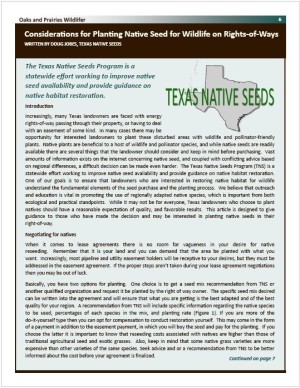
Considerations for Planting Native Seed for Wildlife on Rights-of Ways

Increasingly, many Texas landowners are faced with energy rights-of-way passing through their property, or having to deal with an easement of some kind. In many cases there may be opportunity for interested landowners to plant these disturbed areas with wildlife and pollinator-friendly plants. Native plants are beneficial to a host of wildlife and pollinator species, and while native seeds are readily available there are several things that the landowner should consider and keep in mind before purchasing. Vast amounts of information exists on the internet concerning native seed, and coupled with conflicting advice based on regional differences, a difficult decision can be made even harder. The Texas Native Seeds Program (TNS) is a statewide effort working to improve native seed availability and provide guidance on native habitat restoration. One of our goals is to ensure that landowners who are interested in restoring native habitat for wildlife understand the fundamental elements of the seed purchase and the planting process. We believe that outreach and education is vital in promoting the use of regionally adapted native species, which is important from both ecological and practical standpoints. While it may not be for everyone, Texas landowners who choose to plant natives should have a reasonable expectation of quality, and favorable results. This article is designed to give guidance to those who have made the decision and may be interested in planting native seeds in their right-of-way.
Negotiating for natives
When it comes to lease agreements there is no room for vagueness in your desire for native reseeding. Remember that it is your land and you can demand that the area be planted with what you want. Increasingly, most pipeline and utility easement holders will be receptive to your desires, but they must be addressed in the easement agreement. If the proper steps aren’t taken during your lease agreement negotiations then you may be out of luck.
Basically, you have two options for planting. One choice is to get a seed mix recommendation from TNS or another qualified organization and request it be planted by the right of way owner. The specific seed mix desired can be written into the agreement and will ensure that what you are getting is the best adapted and of the best quality for your region. A recommendation from TNS will include specific information regarding the native species to be used, percentages of each species in the mix, and planting rate (Figure 1). If you are more of the do-it-yourself type then you can opt for compensation to conduct restoration yourself. This may come in the form of a payment in addition to the easement payment, in which you will buy the seed and pay for the planting. If you choose the latter it is important to know that reseeding costs associated with natives are higher than those of traditional agricultural seed and exotic grasses. Also, keep in mind that some native grass varieties are more expensive than other varieties of the same species. Seek advice and or a recommendation from TNS to be better informed about the cost before your agreement is finalized.
Figure 1. A seeding recommendation provided by Texas Native Seeds will contain the names of each species as well as Pure Live Seed (PLS), the planting rate, and PLS/acre.

In addition to the exact seed mix, easement agreements should address timing, management, and planting details. Other common negotiation points include steps to be taken in the event the initial seeding is unsuccessful and regarding verification of use of the proper seed mix. Landowners must also use some diligence to ensure that the items outlined in the agreement are followed.
What natives should you choose for your Right-of-Way
Most landowners interested in planting natives already understand the importance of native plant species for wildlife, however, many lack confidence in knowing what plant species to purchase for their project. This can become problematic when you are attempting to buy or specify native seed mixes because many don’t realize or even know what native species exist in their area. TNS recommends that you speak to someone who understands and can explain to you the details associated with such a purchase. One easy way to determine what plant species would occur in your area is to ask one of your local Texas Parks and Wildlife Biologists or one of the TNS staff.
Click here for full article.